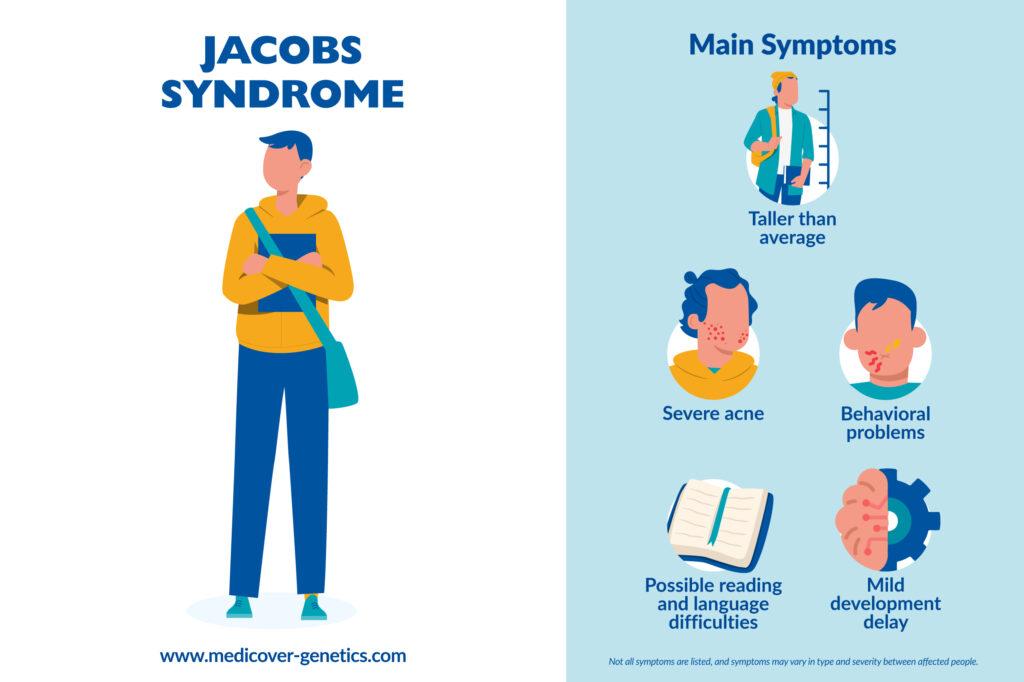Jacob’s syndrome, or double Y syndrome (47,XYY), is a rare chromosomal disorder characterized by an additional Y chromosome in males. Characteristically, patients show above average height, but are otherwise physically inconspicuous and usually have normal fertility and IQ.
Also called
Jacob’s syndrome is also known as:
- Double Y syndrome
- XYY karyotype
- XYY syndrome
- YY syndrome
Symptoms
Symptoms of XYY syndrome vary from person to person.
Symptoms include:
- Above average height
- Cystic acne
- Mildly delayed development
- Reading and language difficulties, causing emotional disturbances and reduced frustration tolerance
- Behavioral problems, such as explosive temper, hyperactivity, attention deficit, impulsivity, and antisocial behavior
Fertility and IQ are usually normal. Scientific studies have shown that boys and men with an XYY pattern who are in a stable familial environment are not more likely to develop behavioral problems than others. Offspring of XYY males do not have an increased risk of gonosomal aneuploidies.

Frequency
XYY syndrome has an incidence of approximately 1:1,000 in male newborns.
Causes
An extra Y chromosome causes XYY syndrome.
Inheritance
XYY syndrome is not inherited. It is caused due to an error in cell division prior to conception.
Differential diagnosis
Syndromes with similar symptoms to XYY syndrome include Klinefelter syndrome, Sotos syndrome, and Marfan syndrome.
Treatment
Symptomatic treatment and early intervention can benefit affected individuals. Therapies include:
- Speech therapy
- Occupational therapy
- Developmental therapy
References
Ross, Judith L et al. “An extra X or Y chromosome: contrasting the cognitive and motor phenotypes in childhood in boys with 47,XYY syndrome or 47,XXY Klinefelter syndrome.” Developmental disabilities research reviews vol. 15,4 (2009): 309-17. doi:10.1002/ddrr.85, https://www.ncbi.nlm.nih.gov/pmc/articles/PMC2876236/.
Ratcliffe, S. “Long-term outcome in children of sex chromosome abnormalities.” Archives of disease in childhood vol. 80,2 (1999): 192-5. doi:10.1136/adc.80.2.192, https://www.ncbi.nlm.nih.gov/pmc/articles/PMC1717826/pdf/v080p00192.pdf.
Bender, Bruce G., et al. “The Development of Four Unselected 47,XYY Boys.” Clinical Genetics, vol. 25, no. 5, 23 Apr. 2008, pp. 435–445, https://doi.org/10.1111/j.1399-0004.1984.tb02013.x
Valentine, G H. “The growth and development of six XYY children.” Birth defects original article series vol. 15,1 (1979): 175-90.
“XYY Syndrome | Male Chromosome Disorder.” Rarediseases.org, www.rarediseases.org/rarediseases/xyy-syndrome/#disease-overview-main. Accessed 12 Dec. 2023.
“47,XYY Syndrome: MedlinePlus Genetics.” Medlineplus.gov, 2013, www.medlineplus.gov/genetics/condition/47xyy-syndrome/ Accessed 12 Dec. 2023.

























